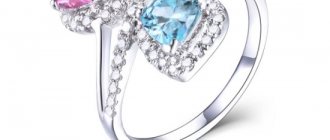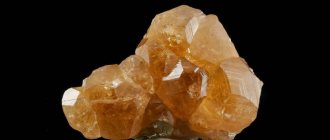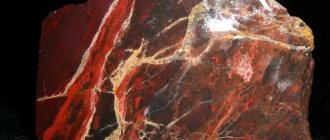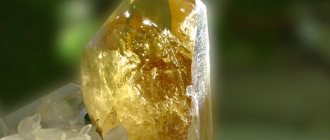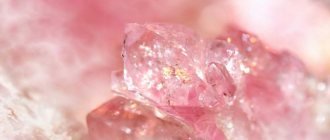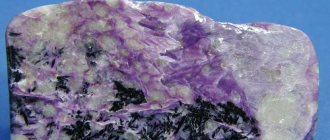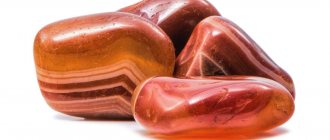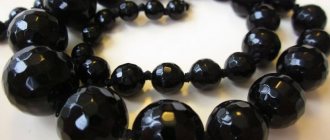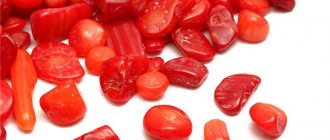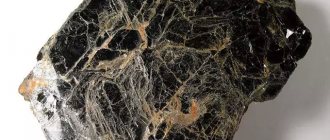Sphene is a stone that has been known for many millennia, but only recently has it been appreciated by jewelers. This was due to the fact that large, profitable deposits of this beautiful stone were discovered less than twenty years ago.
Story
Sphene was revered as magical by the ancient Egyptians. Stones of the solar scale were used in rituals of the temple of the supreme deity Ra. Collars for cats, sacred animals, were decorated with it as a protective amulet.
The mineral has several names:
- titanite (due to the chemical composition of the ore);
- sphene - due to the shape of the crystals, which outwardly resembles a triangle (“sphenos” translated from Greek - wedge);
- greenovite, ligurite - these terms are used by professionals.
It was mainly German scientists who studied the mineral. It was christened titanite in 1795 by the chemist Martin Klaproth.
Mineral Titanite
Russia owes its acquaintance with the stone to the naturalist Gustav Rosa. He was the first to find crystals in the Urals (Ilmen Mountains) in 1842 and scientifically described them.
Interesting Facts
The largest titanite was found in Brazil. Its weight was more than 20 carats. The sphene is kept in the collection. Jewelers do not use stones that are too large, as this affects the weight of the finished jewelry.
In addition to cutting, experts practice heat treatment of minerals, due to which the color of titanite becomes light.
This beautiful and bright mineral is prized among collectors and jewelry lovers. Semi-precious sphene has magical properties that are useful to anyone who wants to become a speaker. It helps you understand yourself and find your path in life. The play of light in titanite makes it a desirable acquisition for anyone who is partial to jewelry.
Description
The mineral sphene in nature is flattened single wedge-shaped crystals and twin intergrowths. Aggregates-needles or “grains” are rare.
The description of the mineral provides an indication of the color created by impurities:
- Iron produces yellowness, greenness or light brownishness.
- If the titanium content is more than 40%, the color turns out to be deep brown. The higher the percentage, the darker the color, even black.
- Chrome creates bright green crystals indistinguishable from emerald.
- Delicate pink tones are the merit of manganese.
- Rare earth cerium colors the crystal blue-violet.
A valued property of sphene is its high dispersion coefficient. Thanks to it, rainbow tints are formed on the edges of the crystal, outshining the diamond.
Varieties
Sphenes have varieties that differ in composition and color:
- Grinovit is a red variety containing divalent manganese ions;
- Tin titanite is a type of titanite containing tin;
- Grotite is a variety containing aluminum and iron;
- Chromium titanite is a bright green variety of titanite containing chromium.
- Yttrium titanite;
- Keilhautitis;
- Yttrotitanite;
- Eucolite-titanite.
The last four varieties contain yttrium.
Physico-chemical characteristics
From a chemist's point of view, sphene is a silicate of titanium and calcium. The main component of the formula is titanium oxide, up to 40%.
The titanium-containing mineral is not found in its pure form, only with impurities.
| Formula | CaTiSiO5 |
| Color | Yellow, green, brown to black |
| Stroke color | Colorless or white |
| Shine | Glass or diamond |
| Transparency | Opaque to translucent, sometimes transparent |
| Hardness | 5 — 5,5 |
| Cleavage | Perfect |
| Kink | Uneven, conchoidal; fragile |
| Density | 3.40 - 3.54 g/cm³ |
| singonia | Monoclinic |
| Refractive index | 1,885 — 2,050 |
Under the soldering tube, the agglomerate melts at the edges, turning into violet glass.
The physical properties of sphene exclude refining. Only heat treatment can lighten dark specimens.
Place of Birth
The mineral does not form mega-deposits, it is just an accompanying rock. Sphene is found in syenite pegmatites, sometimes in igneous rocks.
Several countries have titanium ore reserves, each with its own color:
- Switzerland, Austria – dark brown, rich light green, white transparent stones;
- Norway, Italy - yellow, reddish, green;
- USA, Canada, Mexico, Brazil - yellow;
- Russia – golden, pink.
However, the material suitable for cutting is rare; the number one supplier is Madagascar. It is followed by Pakistan, Tajikistan, Sri Lanka, India, Myanmar, Brazil, and the USA.
In Russia there are large deposits of stone in the Urals and the Kola Peninsula. These are collectible samples plus industrial raw materials. Jewelry stones are found beyond the Urals: Yakutia, Khabarovsk, Primorsky territories, and the Baikal region.
Origin of the mineral
In small quantities as an accessory impurity, titanite is found quite often in igneous rocks (granites, syenites, trachytes, andesites, etc.) in association with feldspars, nepheline, aegirine, zircon, apatite and other minerals. In larger crystals it is also common in pegmatites of predominantly syenite composition. It is less common in contact-metasomatic formations under the influence of less acidic magmas on limestones and is observed in paragenesis with diopside, garnet, epidote, chlorites, magnetite, etc.
Sometimes it is quite characteristic of some metamorphic rocks (gneisses, mica and chlorite schists, amphibolites, etc.). In well-formed crystals it is also observed in Alpine-type veins with calcite, chlorite, epidote, albite, adularia, etc.
When exposed to subsequent hydrothermal carbon dioxide solutions, it decomposes to form calcite, quartz and cryptocrystalline rutile or anatase; sometimes transforms into brookite or perovskite. Pseudomorphoses of garnet on titanite are also known.
In the weathering zone, as a chemically stable mineral, it accumulates in placers, although products of its alteration in the so-called xanthitan have been identified in the form of pale yellow films or powdery fine substances, apparently rutile or anatase with hydroxides of other elements.
It is found in apatite deposits among nepheline-apatite-titanite rocks on the Kola Peninsula. It is observed both in the form of irregular grains up to 1 cm in diameter, and in the form of prismatic, elongated along the axis of crystals with a predominant development of a {110} prism. Also very original are needle-shaped, radial or fibrous titanite aggregates with a pinkish or yellowish tint, located as later formations between grains of other minerals.
Where is the stone used?
Sphene has found application in industry, beauty and among collectors.
Jewelry
Jewelry grade stones make up a tiny share of the total raw material, on the market only since 2004. But jewelry making is a significant area for using sphene.
Decoration with sphene stone
In order for the aesthetic qualities of sphene to be maximized, it is cut like first-line gemstones - using diamond or mixed methods. Most often these are yellow-green or light brown stones - they are stronger than others.
The richness of color allows you to choose a stone to match the color of your eyes or wardrobe. They can be flaunted as a jewelry curiosity.
Jewelry with sphene is decorated with a noble frame.
Other areas
For metallurgists, mechanical engineers, and the aviation industry, ore is important as a source of titanium. Valuable raw materials are supplied by the Kola Peninsula.
Objects of desire for collectors are large agglomerates and intergrowths, and other fragments with sphene.
Industries of application of sphene
Sphene is a semi-precious stone.
It is characterized by low hardness, but excellent optical properties, in which it is second only to diamonds. When processing it, mixed and brilliant cuts are used. When making jewelry, sphene is often combined with other stones, for example, topaz and cubic zirconia, which looks very delicate and beautiful. In jewelry, yellow, green and light brown specimens of sphene are in demand, which contain chromium and zinc and are more durable.
In addition to the jewelry sphere, sphene is titanium ore and a source of titanium for industrial needs. The mineral contains about 40% titanium oxide and is easily enriched.
Stone cost
The cost of faceted sphene depends on weight, color, and cut quality.
Order of prices for products (thousand rubles):
- bright green (cut, 4.5 carats, Madagascar) – 50;
- yellow (cut, 4.3 carats, Madagascar) – 27–29;
- ring (green-yellow stone, 1.6 carats, silver) – 7.5;
- pendant (brownish stone, 2.6 carats, silver) – 8.1.
Yellow stone is cheaper than pink, brown or green with similar parameters.
How to care for stone
The beauty of sphene competes with diamonds and emeralds. But in terms of physical parameters it is inferior.
Therefore, caring for the stone requires careful care:
- A separate box is allocated so that the stronger “neighbors” do not cause damage.
- Protect from falls and impacts.
- Protect from household chemicals, hot water and heat sources.
A ring, bracelet, ring with sphene require caution when worn.
- Jewelry should not be worn in hot, sunny weather, on the beach, in the pool, or in the sauna.
To clean the inserts, use mild detergents and warm water.
Therapeutic effect
Traditional medicine associates the healing properties of the stone with color:
- Yellow. They increase appetite, normalize the functioning of the gastrointestinal tract, remove waste and toxins. Supervise the condition of the liver and kidneys. Regulate metabolism and mental activity.
- Green. Strengthens vision and gives rest to the eyes. Relieves headaches, migraines, hypertension. Calms the nerves.
- Brown. They take care of mental health, mental balance, and mood. Thereby maintaining general physical condition.
- Sphene of any color is suitable for relieving toothache and inflammation in the oral cavity. It also inhibits the development of bone and joint ailments.
Healing properties appear when the stone comes into contact with the human body.
Magic properties
The magical properties of sphene are useful for practicing sorcerers and ordinary people.
How is sphene useful?
The former, with the help of the mineral, improve personal superpowers or comprehend new areas of magic.
The mineral is held in high esteem in the southern United States. Adherents of the voodoo cult have been making protective talismans from sphene for centuries.
People who are far from magic can achieve success in life with the help of a stone:
- Develop the talent of a boss, organizer or speaker. This property is useful for public figures, businessmen, and careerists.
- Strengthen memory and ability to concentrate. Activate your intuition, your sixth sense. This is valuable in conditions of information “spam”: a person will easily filter incoming data, weeding out what is unnecessary.
Sphen embodies well-being and tranquility. But it only helps in projects with a plus sign.
Talismans and amulets
Practicing magicians have discovered the “specialization” of products with stone:
- the ring attracts luck in love and finances;
- a ring or earrings with sphene are needed for people who want to develop intuition and learn to hear the prompts of their inner voice;
- pendant or pendant will block external negativity (sideways glance, damage, curse).
Ring with sphene
If there is no jewelry, a stone or product will do.
Which is better to make a talisman?
In Ancient Egypt, it was believed that the magic stone was endowed with special power by the great god Ra, and therefore the gem shimmered brightly under the sun's rays. Practitioners advise following ancient traditions and inserting a pebble into a cat's collar to protect against damage.
If a person is looking for love, then a ring with such a gem will help him in this.
Depending on the purpose of the practice, it is recommended to make the following types of magical talismans:
- Ring. The amulet will provide the owner with luck, help in business, improve the financial sphere and attract true love. The best setting for a magic stone is gold.
- Earrings. The female talisman is suitable for practitioners who want to enhance abilities and develop intuition. It is important to listen to your own feelings, even if they contradict the arguments of reason.
- Pendant and beads. The decoration will protect against magical attacks, envious people and energy vampires.
Sphen and the Zodiac
Astrology has not revealed mineral preferences. It is believed that according to the horoscope, he suits all signs of the Zodiac.
| Zodiac sign | Compatibility |
| Aries | + |
| Taurus | + |
| Twins | + |
| Cancer | + |
| a lion | + |
| Virgo | + |
| Scales | + |
| Scorpion | + |
| Sagittarius | + |
| Capricorn | + |
| Aquarius | + |
| Fish | + |
